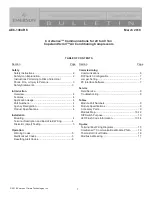
(©Aug, 2007)
FLAiR Series Installation, Operation & Maintenance Manual
Air Technology Systems, Inc.
3-1
3.0
START-UP/COMMISSIONING
3.1 Operation
For new installations, ensure the unit is ready to
operate by going through the Checklist for Completed
Installation, located in Appendix A, prior to start-up.
NOTE
A Warranty Registration and Start-Up Checklist
is provided in the unit data package. It should be
completed during start-up and sent to SATS. This
checklist should be used as a guideline for items
that need to be confirmed during start-up.
Start-up must be performed by a journeyman, refrigera-
tion mechanic or an air conditioning technician.
3.2 Step by Step Start-Up Instructions
CAUTION
For air-cooled outdoor condensers, apply power
to the condenser eight hours before operating
system. This time is required to allow liquid
refrigerant to be driven out of the compressor.
The compressor crankcase heater is energized
as long as power is applied to the unit.
1.
Replace all equipment removed prior to performing
the start-up checks.
2.
Apply power to start the precision A/C system at
the main power disconnect switch.
NOTE
The compressor may have a time delay on start-up.
Water/glycol-cooled units have a head pres-
sure regulating valve that has been factory set.
A valve adjustment may be required based on
water temperature or water/glycol flow condi-
tions at your site. (Refer to System Settings
and Adjustments.)
3.
Ensure that all blowers and fans are rotating
correctly and freely without any unusual noise.
4.
Test cooling operation by adjusting the tempera-
ture setpoint below the actual room temperature.
The compressor should come on and the dis-
charge air should feel cooler than the return air.
5.
Test heating operation by adjusting the tempera-
ture setpoint above the actual room temperature.
The source of heat should be energized to in-
crease discharge air temperature.
6.
Test humidification operation by creating a de-
mand for humidification. Use an amp meter to
determine current draw of humidifier. Visually
check for humidity leaving the steam head or feel
the cylinder to verify if the humidifier is operational.
In all cases, 1 to 6 hours might be required to see
the desired level or a rise of humidity in the
conditioned space. Once room conditions have
been programmed or set, a repeat visit to the
conditioned site may be required to ensure the
humidifier is meeting the rooms’ requirements.
7.
Test dehumidification operation by creating a
demand for dehumidification. Decrease the
dehumidification setpoint 10% below the actual
room conditions. The compressor circuit will be
energized to begin the dehumidification process.
While in this mode, the room temperature may
decrease and the reheat function may activate. As
conditions in the room change, you may have to
re-adjust the setpoint as you check the operation.
An adequate heat load within the space is re-
quired. For Electric Reheat, use an amp meter on
the heater circuit to determine if heater is opera-
tional. For Hot Gas Reheat, using a voltmeter and
a point to point method, ensure the control signal
has energized the hot gas reheat solenoid coil.
For Hot Water or Steam Reheat, ensure that the
control signal has energized the control valve and
the temperature of the steam or water has de-
creased as it passes through the unit. In all cases
1 to 6 hours might be required to see the desired
level or a decrease of humidity in the conditioned
space. Once room conditions have been pro-
grammed or set, a repeat visit to the conditioned
site may be required to ensure the dehumidifica-
tion mode is meeting the rooms’ requirements.
3.3 Microprocessor Controller
Programming
The microprocessor controller is factory programmed
based on the optional features selected. Most applica-
tions require no field start-up or program adjustment
beyond setting the current date and time. Separate
operating instructions for the controller have been sent
with your unit, including each feature’s factory "default"
setting and the available adjustment range, if appli-
cable.
Summary of Contents for FLAIR series
Page 1: ...FLAiR Series Installation Operation Maintenance Manual Aug 2007 Air Technology Systems Inc ...
Page 42: ... Aug 2007 FLAiR Series Installation Operation Maintenance Manual Air Technology Systems Inc ...
Page 44: ... Aug 2007 FLAiR Series Installation Operation Maintenance Manual Air Technology Systems Inc ...
Page 46: ... Aug 2007 FLAiR Series Installation Operation Maintenance Manual Air Technology Systems Inc ...
Page 48: ... Aug 2007 FLAiR Series Installation Operation Maintenance Manual Air Technology Systems Inc ...
















































